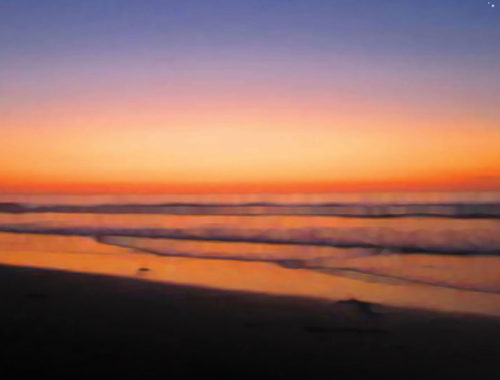
Hale Ohia: Volcano’s Enchanted Road to Old Hawai‘i
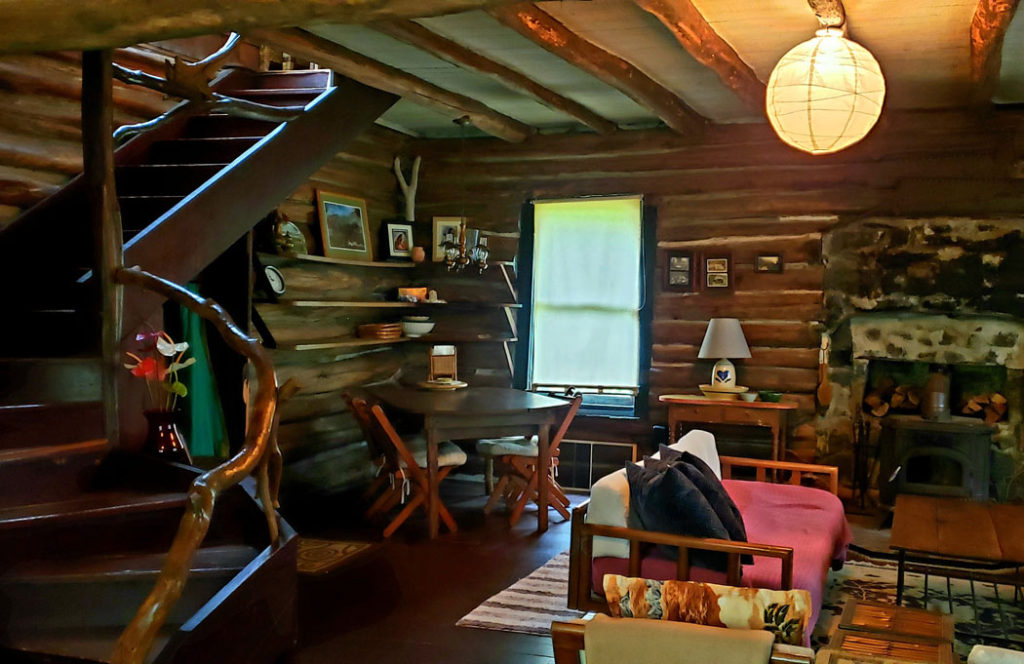
By Sara Stover
Less than two miles outside the entrance to Hawai‘i Volcanoes National Park, in the heart of the small artists’ community of Volcano Village, is the Hale Ohia tract. Hidden by a thick grove of ‘ōhi‘a and Sugi pine trees, one might easily drive right past the historic neighborhood. Although the highway now divides the rural street and a few newer houses have been constructed at the end, historic charm still fills the air.
For hundreds of years, Kīlauea’s eruptions have been magnificent, yet relatively safe, drawing visitors and residents to the town of Volcano in growing numbers. At an elevation of 3,750 feet, Volcano Village’s cooler climate has long attracted those looking to escape the summer heat for more than a century. Other DLNR-recognized historic houses were constructed on Hale Ohia Road, intended to be modest retreats for managers from plantations such as the Ka‘u Sugar Company.
In 1846, a grass structure was built in the national park to serve as its hotel. By 1877, a more “modern” building was erected, the present-day Volcano Art Center. Known as the Volcano House at the time, it could better accommodate the increase in visitors including Mark Twain and Robert Louis Stevenson, with many spilling over into Volcano Village.
Between 1920 and 1930, Hawai‘i’s economy boomed and the majority of the Hale Ohia Road homes were built. Today, the variety of architectural examples in this small neighborhood is impressive. After a day spent exploring the park, lodgers can cozy up in front of the fire in a quaint Craftsman bungalow, a bright summer cottage, or even a rustic log cabin. Recently we had the chance to visit a few of the most historic of these homes.
Mr. Terry’s Log Cabin

Moss-covered ground surrounds Hale Ohia Road’s enchanted log cabin, and despite amenities like WiFi and TV, the home’s historic characteristics remain intact.
“That’s the reason why Mr. Terry gave the paniolos kuleana to use the cabin when they were passing through on the way to South Point with their cattle,” says cabin owner Cynthia Rubinstein.
The home is one of two true log cabins known to exist in the state of Hawai‘i (the other is on state forestry property).
At first glance, the notched ‘ōhi‘a log cabin’s only unique attributes are its island location and its atypical two stories. Upon closer examination, however, it’s clear that the home has 119 years’ worth of unusual stories. Inside, raw hewn wood beams and columns are exposed, and the winding staircase is accentuated by railings of naturally-shaped ‘ōhi‘a.
“Those are Terry’s carvings on that ‘ōhi‘a log next to the fireplace,” explains Cynthia. “The ship and the palm trees illustrate his journey from the East Coast to Hawai‘i.”
In the central living area, just outside the entrance to the kitchen, a section of floorboards are cut straight across, suggesting that bootlegged liquor was hidden underneath. Inside the kitchen, a mysterious button protrudes slightly from the wall.
“According to Volcano lore, the cabin was a speakeasy at one point and the Volcano Store across the street was a bordello,” reveals Cynthia. “Since the kitchen did not exist until an extension was added, it’s safe to assume that the button on the interior wall—once the outside wall—was to buzz in speakeasy guests.”
Hidden in the cabin’s logs are a few more secrets that can only be uncovered in person.
The Hutchinson Sugar Mill House AKA Ka‘u Plantation Manager’s Vacation Home
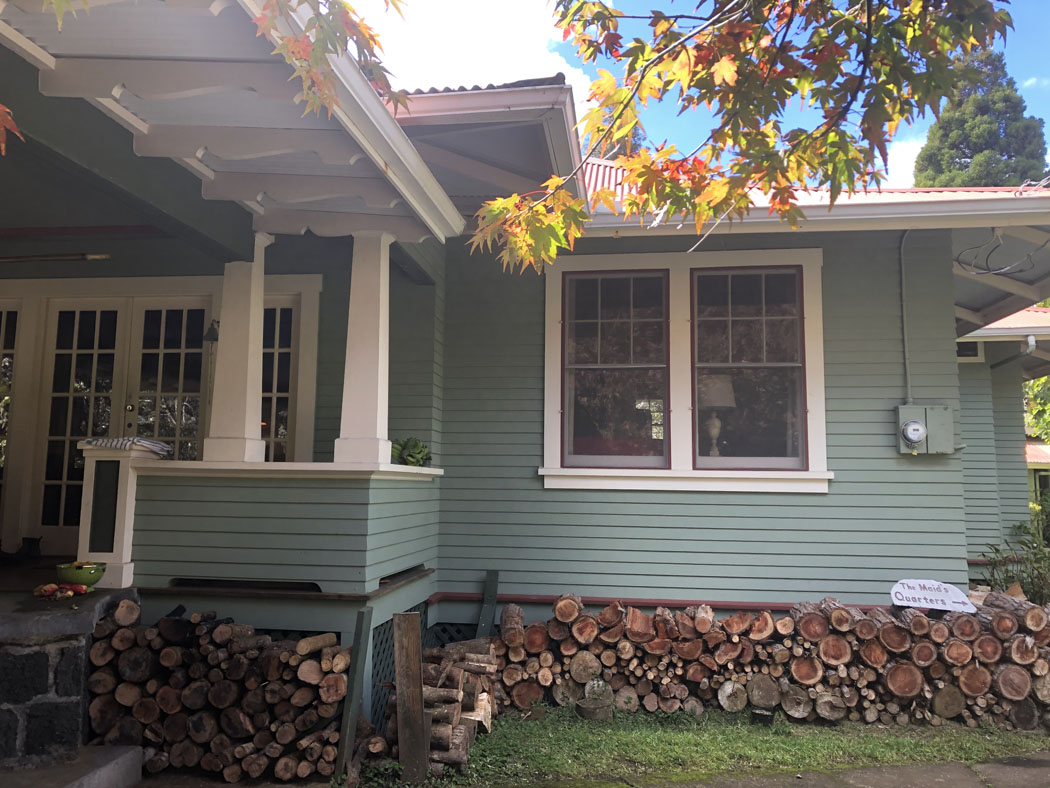
James Beatty, manager of the Hutchinson Sugar Plantation Company, constructed what is now the Ka‘u Plantation Manager’s Vacation Home in 1932. Typical of the style that pervaded Hawai‘i, this Craftsman bungalow features a porte-cochère with lava rock pedestals and curved lava rock railings.
The centered outset porch and chimney lend a dignified quality to this demure house with its shiplap siding. French doors lead to the main living area within, where the lava rock chimney and its subtle art deco design steal the spotlight.
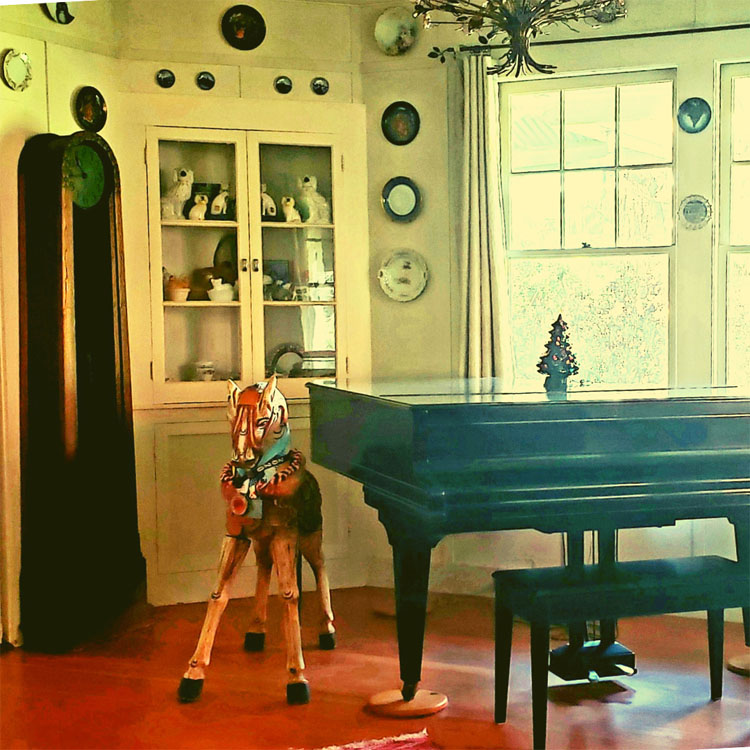
“What I find the most interesting is the hardwood floors,” says Jillian Marohnic, who lives in the home with her husband, Todd. “These floors are made of uncut Douglas fir.” The same board continues through the kitchen with its built-in cabinets to the dining room and its corner built-ins.
Today, the dining room is furnished with a stunning grand piano and a grandfather clock that stops every time there is a significant earthquake. “During the continual volcanic eruption of 2018, we experienced a 5.3 earthquake nearly every day and the clock would always stop, so we knew exactly when the earthquake had occurred,” Jillian elaborates.
On December 20, 2020, a new eruption commenced. It hasn’t, however, deterred visitors from renting the Maidʻs Quarters Cottage, which was built behind the Ka‘u Plantation Manager’s Vacation Home at the same time as the original bungalow. Surrounded by a thicket of tree ferns and ‘ōhi‘a, the vacation rental attracts guests from near and far who are looking for a memorable rainforest experience.
The Ola‘a House

‘Ola‘a is the Hawaiian word for “lively,” as well as the original name for Kea‘au, where the ‘Ola‘a Sugar Company leased around 4,000 acres of land more than 100 years ago. By 1902, the operation had become the largest sugar producer on Hawai‘i Island, under plantation manager Bill McBride’s leadership.
In 1935, the McBride family constructed their summer home on a raised post and pier foundation with a lattice skirt. True to typical Hilo architecture, the single-story home boasts high ceilings and crank-out windows.
The Ola‘a House is inspired by the Craftsman bungalows pervasive in plantation management housing, with an entrance defined by lava rock walls, a large porte-cochère, and a basement to house the McBride’s maids.
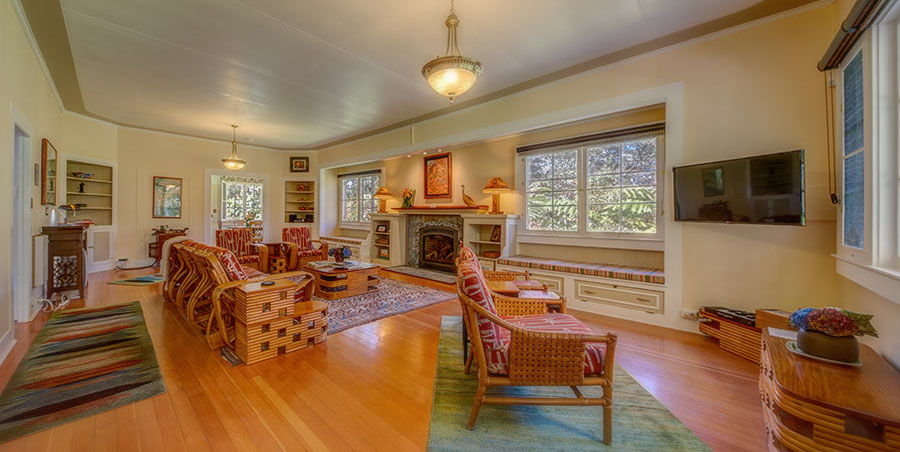
“Of Scottish descent, the McBride family would likely have spent their summers riding horses, hunting pigs, and generally enjoying the cooler climate when staying in Volcano,” notes owner Albert Jeyte, former Magnum PI make-up artist and co-founder of Kilauea Lodge.
Today, guests can sip tea in the sunroom, stroll through the garden, curl up on one of the window seats to read, and play games in front of the expansive living room’s gas fireplace on chilly upland nights.
With the fortitude to withstand countless earthquakes, the aptly named Ola‘a House has been thoughtfully updated by Albert with vibrant colors, original art from local artists, and vintage Hawaiian furnishings, including a replica of the four-poster royal bed frame currently found in the Hulihe‘e Palace. The two-bedroom home is also conveniently located across from Tutuʻs Place, which is owned by Albert’s wife, Lorna.
Tutu’s Place

Surrounded by native forest, Tutuʻs Place is owned by Hawai‘i-born Lorna Larsen-Jeyte, who co-owned Kilauea Lodge with her husband before selling it in 2018. One of the older summer cottages in Volcano Village, the single-wall, plantation style home was constructed by the Kimi family between 1929 and 1935.
Initially built for their grandmother, Tutu’s Place was also used by the Kimis as a summer escape. It isn’t hard to imagine the late William “Uncle Billy” Kimi, Jr. playing in the property’s garden as a child, before growing up to be a successful hotel manager and local icon.
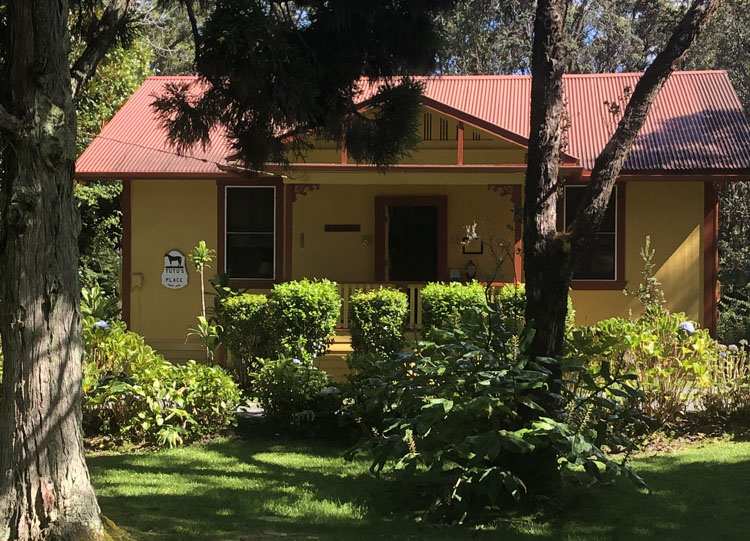
Most of the village’s cottages were used by the island’s families as a reprieve from the stifling heat of summer, and Lorna’s family was no exception. As a child, she would visit Tutu’s Place with her father and stepmother, spending the days hiking, and picking ‘ōhelo berries and white strawberries.
By 1968, Ruth Warner had bought Tutu’s Place, residing there until just a few weeks before her death in 1994. Nicknamed “the ball of fire,” Tutu Ruth is remembered by her neighbors as a lively lady who adored her garden and her pets. The daughter of famous vaudeville actress Sophie Tucker, Ruth was also known for breaking out into song at local parties.
“I purchased the house from Tutu Ruth. Shortly after, she passed away,” recounts Lorna. “This is still her cottage, however, and she’s let us know it!”
In 1995, Tutu’s Place underwent an upgrade and Lorna contracted artist Gwendolyn OʻConnor to paint a mural on the living room wall. Soon after the painting was finished, guests reported witnessing a ball of fire roll across the living room floor and then vanish.
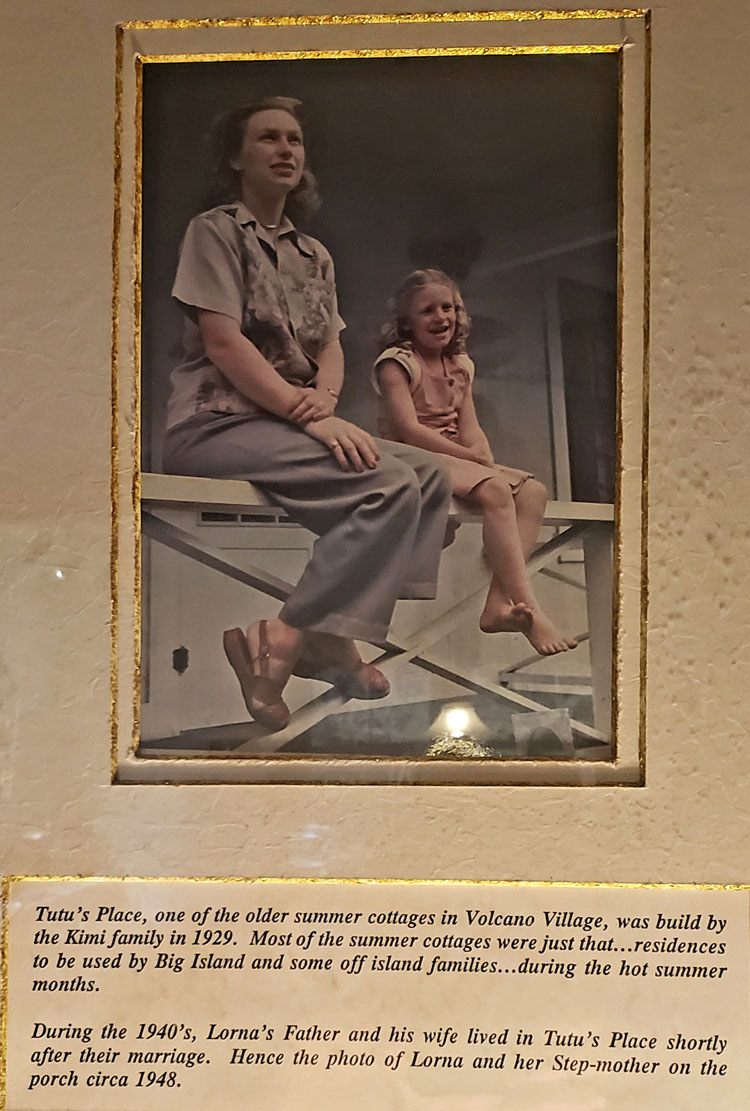
Lorna concluded that the mural was not well received, and promptly had it painted over and the cottage blessed. Since then, Ruth the Fireball has made no further appearances.
“This confirms what the workmen who restored Tutu’s Place stated,” says Lorna. “There is great spirit and joy in the house. Must have been a lot of good mana over the years. All Tutu’s!”
With a stained-glass window depicting ‘i‘iwi and ‘amakihi birds frolicking among flowers, the simple cottage echoes that joy today. Simultaneously, Tutu’s Place reflects the architecture of an era gone by with tongue and groove walls, and a Hilo-style corrugated metal gable roof.
Within Tutu’s Place and the other Hale Ohia homes, you’ll find just the right pairing of modern conveniences and nostalgic decor. Outside, dense, lush forest has taken the place of the shrubs and bushes prevalent in the 1930s. Even so, there is an undeniable blend of calm and adventure in the air that transports visitors back to the days of Old Hawai‘i. ❖
For more information:
CRubinstein.com/property/log-cabin
VolcanoVillage.net
VolcanoHeritageCottages.com



